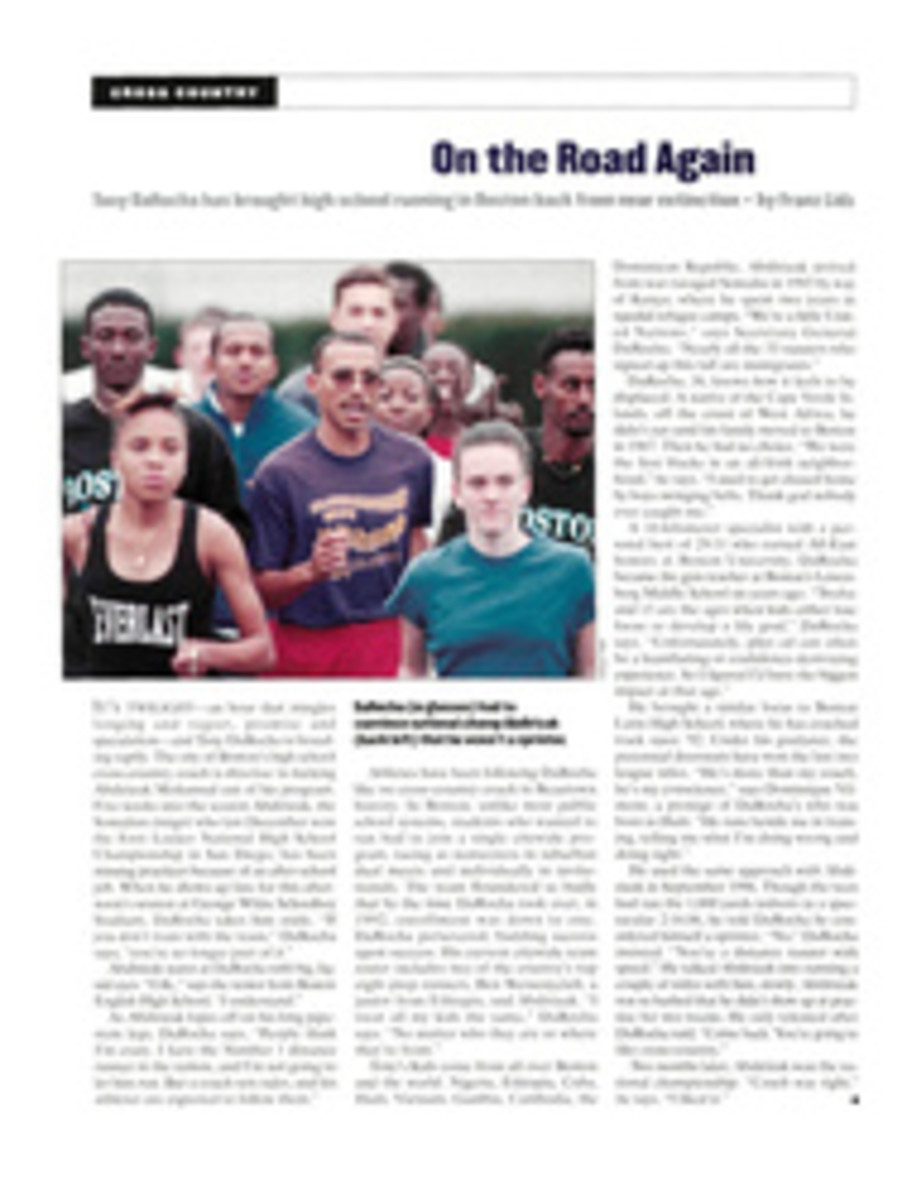
VILLENEUVE WINS F/1 TITLE--TOO FAST IN ATLANTA?--THE END FOR EMMO
HE REIGNS IN SPAIN
In the season-ending Grand Prix of Europe at Jerez, Spain, on
Sunday, Jacques Villeneuve showed rough-driving Michael
Schumacher that winning the Formula One world driving
championship by knockout--as Schumacher did in 1994--isn't
nearly as easy against a veteran of the CART circuit, where
contact between cars is more common than in F/1.
On the 48th of 69 laps, Schumacher was leading the race when
Villeneuve, who won the CART season championship in '95 before
moving to F/1 last year, closed suddenly at the end of the
straight. As they entered the hard righthand corner called Dry
Sack, Villeneuve darted to the inside--"I was actually in the
grass," he said later--and pulled alongside Schumacher, who
veered his Ferrari's right front wheel hard into the left side
of Villeneuve's Williams-Renault. "Jacques braked so late that
he would have gone off if I hadn't turned into him," Schumacher
said afterward, with a straight face. "Neither of us would have
made the corner braking so late."
Schumacher nailed Damon Hill in much the same fashion during the
'94 season-ender in Australia to guarantee himself the
championship. But this time Villeneuve, accustomed to jolts to
the sidepods, held his inside line. Schumacher bounced off and
slid into a gravel runoff area, finished for the day. "I wasn't
really surprised when he finally decided to turn in on me," said
Villeneuve. "I knew I was taking a big risk. I really thought
I'd broken the car. He hit me really, really hard. For the rest
of the race, the [car's] rear end, mostly on righthanders,
didn't feel very stable."
Villeneuve hung on to the lead until the final lap, when he
allowed Finland's Mika Hakkinen and Scotland's David Coulthard
to dart past and finish one-two in a pair of McLaren-Mercedes.
Had Villeneuve slugged it out with the McLarens, he would have
risked failing to finish. That would have given the driving
title to Schumacher, the 28-year-old German who had gone to
Jerez with a one-point lead over Villeneuve in the standings,
courtesy of F/1's rule makers. They had stripped Villeneuve of
two points he earned in the Grand Prix of Japan on Oct. 12
because he had ignored a yellow flag during a practice
session--his fourth such violation of the season.
Nevertheless, Villeneuve, a 26-year-old Canadian, became the
first North American to win the F/1 driving championship since
Mario Andretti in 1978. Villeneuve is used to overcoming
difficulties. In winning the Indianapolis 500 in '95, he made up
a two-lap penalty--some observers thought it was a questionable
call--for passing the pace car during a caution.
GET A GRIP
Don't be surprised if the pole sitter for the Winston Cup season
finale, the NAPA 500 at Atlanta Motor Speedway on Nov. 16,
cracks 194 mph--almost 8 mph faster than Robby Gordon ran in
winning the pole for the Primestar 500 there in March. The
1.54-mile track was reconfigured and repaved over the summer,
and the result has been much faster lap times. The speeds
reached in testing at Atlanta last week (more than 200 mph on
the straights, with lap averages in the low 190s) were so fast
that drivers and crew chiefs alike were unnerved. "Some of the
guys who like to be known as the bravest drivers have been the
first to tell me it's too fast," says Robert Yates, owner of the
Fords driven by Ernie Irvan and Dale Jarrett, who turned a
191-mph lap.
Such speeds had been unheard of at Atlanta. "The track radius is
tight at Atlanta, so there's less margin for error," said Jeff
Gordon's crew chief, Ray Evernham. "If anybody makes even one
little mistake, he's going to pay a big price."
The changes in the configuration of the track--what was the
backstraight is now the frontstraight, with a dogleg that gives
cars a straighter line into Turn 1 and out of Turn 4--allow
drivers to maintain higher speeds. "We've never pushed tires and
chassis as hard as we're pushing here," said Yates. He added
that unless NASCAR mandates that teams stop running with tire
pressures lower than what Goodyear recommends for Atlanta, tires
could easily tear off rims in turns.
Check out more racing news from Ed Hinton at www.cnnsi.com
COLOR PHOTO: DUSAN VRANIC/AP After Schumacher took himself out of the race, Villeneuve (above) took a Sunday drive to his first world title. [Jacques Villeneuve racing]
COLOR PHOTO: GEORGE TIEDEMANN The two-time Indy 500 winner defied the odds long enough. [Emerson Fittipaldi in winner's circle]
AN APPRECIATION
Emerson Fittipaldi
When Emerson Fittipaldi began racing in Formula One in 1970, the
odds were one in seven that any given driver would not survive
the season. But the Brazilian lived through 11 years on that
circuit and 13 more in CART, winning two F/1 world championships
(1972 and '74) and two Indianapolis 500s ('89 and '93).
Now, after suffering spinal-cord injuries in two crashes just 14
months apart--one in an Indy Car and one in an ultralight
aircraft he was flying in early September--the 50-year-old
Fittipaldi has decided it's time to adopt a more sedate
lifestyle. He announced recently that he is giving up dangerous
activities, including car racing.
That's good news, because few drivers have defied the odds as
long as Fittipaldi. The increasingly monochromatic racing world
needs a figure as colorful and charismatic as Emmo, as legions
of fans know him, even if he is not behind the wheel but behind
the wall, as an Indy Car team owner, which is his plan.
Fittipaldi's relaxed personality belied his intense driving
style. He won at Indy in 1989 with an audacious last-lap dive
inside race leader Al Unser Jr., bumping Unser's tires and
sending him into the wall. Two weeks later at the Detroit Grand
Prix he crashed in the first turn. He rejoined the race in last
place, and won. Fittipaldi often compared driving exotic cars to
"making love to a beautiful woman--when it is right, you are as
one." Rarely if ever did he say a car was running great. Rather,
he would say, "She is beautiful today."
After a crash at Michigan in July 1996 nearly left him a
quadriplegic, he stubbornly refused to rule out a return to
racing. He sat out the '97 CART season and was toying with the
idea of running a limited schedule next year. But on Sept. 7
during a visit to his Brazilian orange groves, Fittipaldi
crashed his ultralight plane in a swamp. Rescuers needed 11
hours to find the wreckage, and Fittipaldi required neurosurgery
to rebuild a section of his lower spine. He will wear a torso
brace for six months.
It's doubtful that he can quit his addiction to speed cold
turkey, however. Fittipaldi likely will be seen zooming up and
down Biscayne Bay, near his Miami home, in one of his cigarette
boats. She'll be beautiful, of course. --E.H.
.478
Time, in thousandths of a second, that it takes Tony Schumacher
to react to the green light and start his Top Fuel dragster
moving down the quarter-mile strip. By the time one second has
elapsed, he has reached 100 mph. By the time three seconds are
up, he's going faster than 250 mph.

